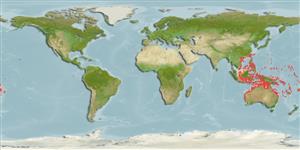>
Eupercaria/misc (Various families in series Eupercaria) >
Labridae (Wrasses) > Cheilininae
Etymology: Pteragogus: Greek, pteron = wing, fin + Greek, ago = to drive (Ref. 45335).
More on author: Bleeker.
Environment: milieu / climate zone / depth range / distribution range
Ecología
marino asociado a arrecife; rango de profundidad 2 - 64 m (Ref. 86942). Tropical; 26°N - 25°S, 108°E - 173°W
Distribución
Países | Áreas FAO | Ecosistemas | Ocurrencias, apariciones | Point map | Introducciones | Faunafri
Western Pacific: Indonesia to the Coral Sea, north to Guam, south to southeastern Australia. Recently recorded from Tonga (Ref. 53797).
Tamaño / Peso / Age
Maturity: Lm ? range ? - ? cm
Max length : 15.0 cm TL macho / no sexado; (Ref. 9002)
Short description
Claves de identificación | Morfología | Morfometría
Espinas dorsales (total) : 9; Radios blandos dorsales (total) : 11; Espinas anales: 3; Radios blandos anales: 9. It can be distinguished from the other species by its longitudinal lines along the body (Ref. 48636). Differs from P. cryptus and P. guttatus by having IX, 11 rather than X, 9-10 dorsal rays and males with filamentous extensions on first two rather than the first four interspinous dorsal membranes (Ref. 37816).
Found in various habitats from shallow algae reefs to deep offshore on soft bottom with sponges and hydroid colonies (Ref. 9002). Mostly small, secretive species, usually hiding among dense weeds (Ref. 9002). It rarely leaves its cover except to move quickly between hydrozoan colonies, but not before having a good look around first to make sure its safe (Ref. 48636).
Life cycle and mating behavior
Maturities | Reproducción | Spawnings | Egg(s) | Fecundities | Larva
Oviparous, distinct pairing during breeding (Ref. 205).
Kuiter, R.H., 1993. Coastal fishes of south-eastern Australia. University of Hawaii Press. Honolulu, Hawaii. 437 p. (Ref. 9002)
IUCN Red List Status (Ref. 130435)
Threat to humans
Harmless
Human uses
Herramientas
Special reports
Download XML
Fuentes de Internet
Estimates based on models
Preferred temperature (Ref.
123201): 25.2 - 29.3, mean 28.4 °C (based on 1669 cells).
Phylogenetic diversity index (Ref.
82804): PD
50 = 0.5010 [Uniqueness, from 0.5 = low to 2.0 = high].
Bayesian length-weight: a=0.01585 (0.00707 - 0.03555), b=2.95 (2.76 - 3.14), in cm total length, based on LWR estimates for this (Sub)family-body shape (Ref.
93245).
Nivel trófico (Ref.
69278): 3.5 ±0.4 se; based on size and trophs of closest relatives
Resiliencia (Ref.
120179): Alto, población duplicada en un tiempo mínimo inferior a 15 meses (Preliminary K or Fecundity.).
Fishing Vulnerability (Ref.
59153): Low vulnerability (10 of 100).
Nutrients (Ref.
124155): Calcium = 82.1 [49.7, 139.3] mg/100g; Iron = 0.716 [0.423, 1.308] mg/100g; Protein = 18.4 [15.6, 20.6] %; Omega3 = 0.171 [0.110, 0.266] g/100g; Selenium = 27.4 [16.4, 48.2] μg/100g; VitaminA = 143 [44, 532] μg/100g; Zinc = 1.66 [1.14, 2.57] mg/100g (wet weight);
